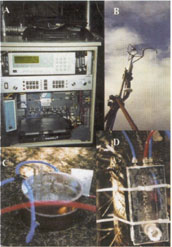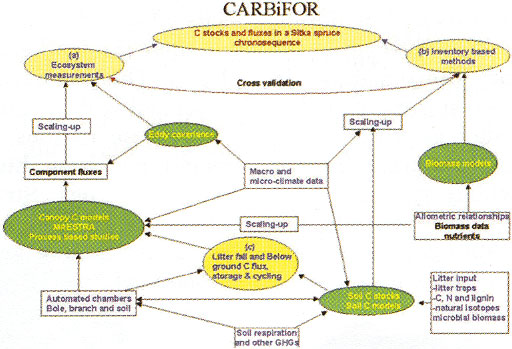| 2003 |

|
YEAR BOOK |
COFORD (National Council for Forest Research & Development) & University College Dublin
|
Assessing carbon stocks and fluxes during forest development - the CARBiFOR Project
|

One approach is to utilise the C sequestration potential of forest ecosystems to offset greenhouse gas emissions. CARBiFOR is a multidisciplinary project cluster, led by Professor Ted Farrell, involving a number of groups within University College Dublin, that aims to provide the scientific basis for maximising C storage and provide the first detailed experimental assessments of the C budgets of Irish forest ecosystems. CARBiFOR runs from 2001 to 2004 and aims to address some of the gaps that exist in the current information of C stocks and C sequestration rates by forest ecosystems. The project is funded by COFORD under the National Development Plan (2000-2006).
The establishment and development of plantation forests causes site disturbance influencing hydrological, nutritional and C cycles. During the early stages of stand development, a low leaf area limits C sequestration due to a limit in the capacity for whole plant C gain. As the stand matures, the capacity for C sequestration increases. However, following harvesting, organic matter decomposition and heterotrophic respiration increase, and the ecosystem changes from being a sink to a source of C. At present there is little detailed information available on when these shifts in the C balance occur or what their magnitude is.
Whilst standardized C inventory methodologies have been developed by the Intergovernmental Panel on Climate Change (IPCC), there is a clear need for studies to reflect national circumstances. Assessments of C stocks in forests are usually based on forest inventory data, with biomass expansion factors (BEF - see glossary) being used to convert merchantable stem wood to total biomass (above- and below-ground). However, there are many uncertainties in estimates of forest biomass C pools, including the amount of forest biomass, the appropriate BEFs, and values for biomass density and C fraction. Furthermore, soil C is not usually included in such assessments. There are also uncertainties in converting these measures into forest C fluxes.
Micrometeorological methods, such as eddy covariance (Figure 1), offer a means to monitor directly the exchanges of trace gases between the biosphere and the atmosphere. These provide an estimate of Net Ecosystem Productivity (NEP), or Net Ecosystem Exchange (NEE). In this technique, atmospheric eddies are sampled for their vertical velocity and the gas concentrations of interest (e.g. H 2 O and CO 2 ).
The objectives of the project are:
-
�To determine C stocks during stand development.
-
�To determine changes in BEFs during stand development.
-
�To determine C fluxes during stand development.
-
�To model age-related changes in net primary productivity (MAESTRA) and net ecosystem productivity during stand development.
-
�To provide improved predictions of C budgets for the selected forest ecosystems.
-
�To use novel stable isotope techniques as an independent approach to (i) validate critical parameters of the CENTURY model (see glossary), and (ii) investigate critical pathways and processes controlling C storage in Irish forest soils.
-
�To determine whether the CENTURY model accurately predicts the soil carbon stocks along a chronosequence (stands covering the age range found in Irish plantations, growing on similar sites) of Sitka spruce.

The UCD research team
Department of Botany: Kevin Black, Ohdran O'Sullivan, Bruce Osborne.
Department of Environmental Resource Management: Ted Farrell, Ken Byrne, Gustavo Saiz, Olaf Schmidt, Jens Dykmans
Department of Forestry: Jack Gardiner, Brian Tobin.
Department of Zoology: Tom Bolger, Brian Reidy.
This consortium brings together a team of researchers who have extensive experience in photosynthetic studies, ecosystem modelling, forest management, and soil processes. This work will provide quantitative data for decision-makers responsible for ensuring the implementation of the Kyoto Protocol.
Glossary of terms
BEF: biomass expansion factor used to convert stand commercial wood biomass into above- and below-ground biomass
EDDY COVARIANCE: a technique used to monitor the exchange of H 2 O , CO 2 ). and heat between the biosphere and the atmosphere. This provides a measure of NEP.
NEP: net ecosystem productivity is the change in ecosystem C storage with time. This is the sum of C gained through photosynthesis and C lost due to decomposition and heterotrophic respiration.
MAESTRA: a 3-D array computer model used to estimate photosynthesis and respiration of forest ecosystems
CENTURY MODEL: a model used to estimate changes in soil C, NEP and forest growth with time.
Contact: Kevin Black, Department of Botany, University College Dublin, Belfield, Dublin 4;
E-mail: [email protected] ; Web: http://www.ucd.ie/~carbifor/index.htm ; http://www.coford.ie